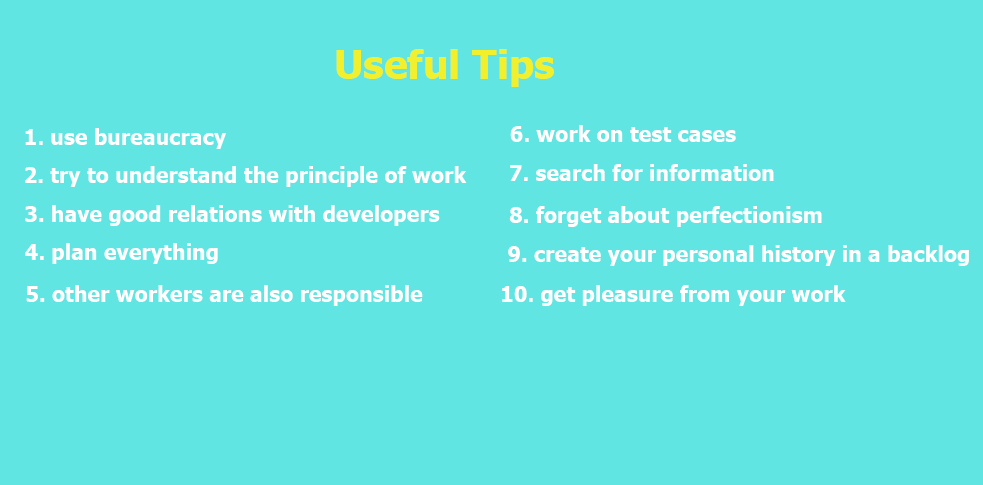You can find below 10 really working lessons taken from the everyday life of a tester.
They will help you to survive at work and will transform you, a frightened fresher, into a tough software quality assurance engineer if all your quality assurance team consists of the one team member, and it’s you.

Useful Tips
Use bureaucracy
There are few categories that can be used by a tester. Bureaucracy and procedures are examples of them.
And it’s true not only because it has been invented for some reason and it’s still actual even nowadays.
When there is only one tester working on a project and in a company, he/she needs not only to do his/her work properly but not be stuck with it.
And here the above-mentioned processes may be useful: for example, we work on specification history and thoroughly record everything in software that doesn’t meet these requirements. And if a developer or another project team member claims that all changes were discussed orally, we will ask him/her to record the changes made.
Don’t be afraid to look like a square if you use bureaucracy: you can say that these requirements were taken from directors who asked you to do some task.
You need to understand the principle of work
The main thing that a tester should know is understanding what developers have done and how. Only if you understand what are the components of work, you’ll be able to instantly catch everything, understand personal borders of responsibility on a certain project.
Understanding will definitely bring new skills that will be useful, especially if a tester wants to become a QA lead.
But you don’t need to do more than you can since it may look funny for your colleagues and directors will definitely make their “correct” conclusions.
Developers are your best friends
In contrast to companies that have whole departments devoted to QA, if a tester is alone, he/she has nobody to ask for help. So you need to ask colleagues about functionality, how to check this, and so on.
A simple example: the project has small functionality of completing an error text block when there are issues with a server but the description of such a functionality is not clear even for a very experienced tester.
And here you should ask how you can check this. A developer will show everything and a critical bug, that a tester has little chances to find, may appear.
Planning and again planning
You can’t do without setting priorities. Clear objectives help not only to understand what a person does and why but also, helps to forget that you need, for example, to check functionality or record bugs in a bug report till the end of the week.
Setting priorities is useful when there are situations when you need to complete the project immediately or present ready functionality, to show it a client.
One more way to record your work is to write everyday plans. This helps a person to organize himself/herself but also to transform work chaos in correct prioritization, building a working schedule for a whole week.
A tester is not the one who is responsible for software quality
Yes, it’s true. Though a tester is responsible for software quality but the task to deliver correctly working software should be done by every project team member.
In other words, a tester can and even must explain this to other stakeholders inside his/her work team.
Work on test cases
Analysis of the methods of functionality testing not only disciplined a person but gives you a good possibility to show directors what you have done.
Search for information
A very simple but working tip that doesn’t depend on the number of testers working in a company (one or more).
Even if you are completely sure how to properly test a certain functionality, such as the login/password form, you can search for methods to execute such tests properly. Also, you can find such test scripts you didn’t even think about.
When you search for something new, you don’t only improve the general process of functional testing but a make serious improvement of so-called experience based testing.
Forget about perfectionism
When a person is responsible for software quality, you don’t want to meet such a thing as a delay of software delivery. It’s very important to understand that all bugs can’t be found and parameters can’t be perfect. If you wait when there will be no defects in a bug report, you will just spoil relations with colleagues and won’t meet a software delivery deadline.
Remember that software can’t be perfect. One of the reasons for this is that we all have different thoughts on what is perfect. It’s impossible to create software for every client separately.
This means that everything comes to searching for a collective compromise.
Create your personal history in a backlog
Give it a name, for example, BUG, and put all new defects that can’t be added to the actual project tasks for some reason. This has numerous advantages.
First, you can explain to a developer any time why everything is so complicated. Second, you can give a developer additional work if he/she has nothing to do.
Get pleasure from your work
Eventually, a tester may be proud of such a fact he/she is the main tester and manages every project.
You will have every project before your eyes, remember everything, and simply get pleasure from the work you do.










Leave A Comment